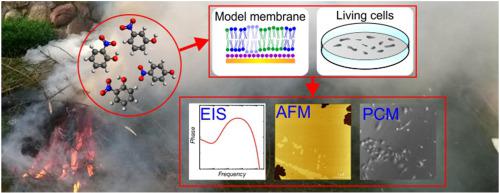Chemosphere ( IF 8.1 ) Pub Date : 2020-11-26 , DOI: 10.1016/j.chemosphere.2020.128996 Marta Majewska , Faria Khan , Izabela S. Pieta , Aleksandra Wróblewska , Rafal Szmigielski , Piotr Pieta

|
Nitroaromatics belong to the group of toxic components of aerosol particles and atmospheric hydrometeors that enter the atmosphere through biomass burning and fuel combustion. In the present work, we report on the cytotoxic effects of a 2-, 3- and 4-nitrophenol mixture on a model eukaryotic-like cell membrane and compared it with in vitro cellular models BEAS-2B (immortalized bronchial epithelial cells) and A549 (cancerous alveolar epithelial cells). A selected model biomembrane comprised of DMPC (1,2-dimyristoyl-sn-glycero-3-phosphocholine), DPPC (1,2-dipalmitoyl-sn-glycero-3-phosphocholine) and POPC (1-palmitoyl-2-oleoyl-sn-glycero-3-phosphocholine) was studied. The electrochemical-based method, combined with atomic force microscopy (AFM) and phase-contrast microscopy imaging, allowed to get insights into the mechanism of cellular function disruption caused by airborne nitrophenols. The efficacy of the method is supported by the data obtained from in vitro experiments performed on cell models. The nitrophenol mixture exhibited cytotoxic effects at concentrations above 100 μg mL−1, as demonstrated by phase-contrast microscopy in real lung cell lines. Electrochemical impedance spectroscopy (EIS) revealed the formation of membrane defects at a nitrophenol concentration of 200 μg mL−1. AFM imaging confirmed the model membrane disintegration and phospholipids rearrangement in the presence of nitrophenols. These observations indicate that particle-bound nitrophenols induce substantial changes in cell membranes and make them more permeable to aerosol, resulting in major cellular damage in the lungs when inhaled. The study provides initial evidence of cellular membrane damage induced by three important nitrated phenols present in the environment.
中文翻译:

选定的机载硝基酚对真核细胞膜模型的毒性
硝基芳烃属于通过生物质燃烧和燃料燃烧进入大气的气溶胶颗粒和大气水凝物的有毒成分。在目前的工作中,我们报告了2-,3-和4-硝基苯酚混合物对真核样细胞膜的细胞毒性作用,并将其与体外细胞模型BEAS-2B(永生化支气管上皮细胞)和A549进行了比较(癌性肺泡上皮细胞)。选定的模型生物膜,由DMPC(1,2-二肉豆蔻酰基-sn-甘油-3-磷酸胆碱),DPPC(1,2-二棕榈酰-sn-甘油-3-磷酸胆碱)和POPC(1-棕榈酰-2-油酰基-)组成锡-甘油-3-磷酸胆碱)的研究。基于电化学的方法,结合原子力显微镜(AFM)和相差显微镜成像,可以深入了解由机载硝基酚引起的细胞功能破坏的机理。该方法的有效性得到了在细胞模型上进行的体外实验获得的数据的支持。如在实际肺细胞系中的相差显微镜所证明的,硝基苯酚混合物在浓度高于100μgmL -1时显示出细胞毒性作用。电化学阻抗谱(EIS)显示在200μgmL -1的硝基苯酚浓度下形成膜缺陷。原子力显微镜成像证实了在硝基酚存在下模型膜的分解和磷脂的重排。这些观察结果表明,与颗粒结合的硝基酚会引起细胞膜的实质性变化,并使它们更易于透过气雾,从而导致吸入时对肺部细胞造成重大损害。该研究提供了环境中存在的三种重要硝化酚引起的细胞膜损伤的初步证据。











































 京公网安备 11010802027423号
京公网安备 11010802027423号